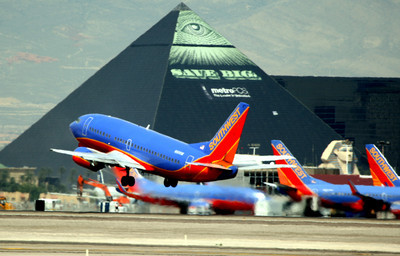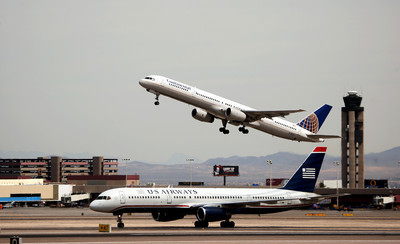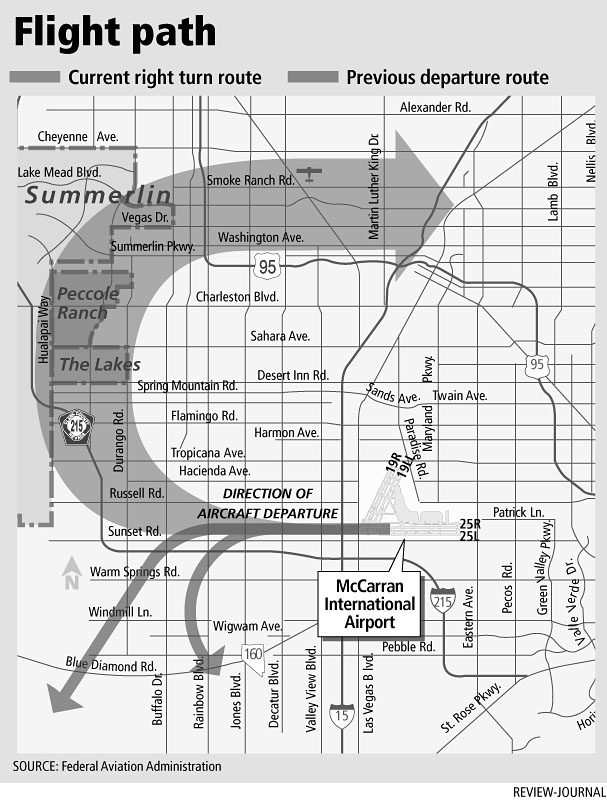Delays increase with new flight plan
Planes looping to the east after taking off from a westward runway were supposed to reduce delays at McCarran International Airport.
Instead, delays have increased by almost 102,000 minutes, or 1,700 hours, in the 11 months since the "right turn" went into effect in March 2007, according to a consultant hired by the city of Las Vegas.
The Federal Aviation Administration last year revived the right turn, which had been discontinued in 2001, saying it would save fuel, boost efficiency and cut down on the planes' runway time.
But the maneuver stirred a furor as loud as a jet engine from neighbors who found themselves under the new flight path and from city officials who opposed routing planes over a dense residential area and into a more cumbersome airspace.
Critics now question the right turn's validity even more, although the FAA dismisses the research as biased and flawed.
"There's been a great deal of skepticism about whether the right turn was implemented to promote efficiency," said Brad Jerbic, Las Vegas city attorney.
Jerbic refused to speculate on what the FAA's ulterior motives might be.
The city, he said, must be careful because it has filed a lawsuit against the FAA in federal court, accusing the agency of doing flawed environmental studies on the right turn.
So far, the city has spent about $400,000 in legal fees and awaits a ruling from the 9th U.S. Circuit Court of Appeals.
The flight-delay report was done by Williams Aviation Consultants, a Phoenix firm that's working with attorneys whom the city has hired to help with the lawsuit.
This report doesn't help the city's court case, though it does cast further doubt on the right turn, Jerbic said.
Data was pulled from the FAA's "OPSNET" Web site, where flight delays are logged, said Barry Yurtis, a consultant with Williams Aviation.
But FAA spokesman Ian Gregor argued that because the city's consultant is compiling the figures, the report should be called into question, even though the raw data comes from the agency's site.
To suggest the right turn hasn't improved McCarran's efficiency would defy logic, Gregor said.
That's like saying cars will back up more on a freeway with two exits than one exit, he added.
By alternating right and left turns, planes can be placed closer together on the runway because they don't need as much space between them as they did when they were all launching the same direction, Gregor said.
As a result, 36 percent more takeoffs occur hourly than before the right turn was restored last year.
Flight delays are up 26 percent throughout the country, in part because air travel is finally rebounding to pre-9/11 levels, Gregor said. With more planes vying for air space, delays will naturally increase, he said.
"It had nothing to do with the conditions at the airport," Gregor said. "To argue that this is unique (to McCarran) is disingenuous."
But Yurtis countered that air traffic at McCarran has only increased by 1 percent since the right turn was implemented. Meanwhile, flight delays escalated by 26 percent in that time, even when removing weather delays from the equation, he said.
"The right turn has impacted delays and increased delays," Yurtis said. "The statistics bear it up."
Because of the lawsuit, Yurtis said he couldn't speak publicly on what might be creating the snags.
Kell Houston, who lives near The Lakes, south of Sahara Avenue, complained that he has had to tolerate bursts of jet noise at random times since the right turn went into place.
Now the right turn appears to be a failed experiment, adding insult to what he's enduring, Houston said.
"I think the whole reasoning behind what they did has no validity. What the heck are they doing?" he asks.
Gregor, however, contends that after the right turn was instituted, there were fewer delays in the remaining eight months of 2007 than in the same period in 2006.
Flight delays fell by about 9 percent, he said.
Yurtis dismissed the findings, calling it a typical FAA tactic to cherry-pick the most favorable data.
Why choose eight months? he said. Why not 10 months, or 11 months?
"I've seen it done before," said Yurtis, who noted he worked for FAA for 25 years, including as manager of the Los Angeles air traffic control center.
Jerbic said the right turn never made sense logistically.
The path conflicts with aircraft coming in and out of North Las Vegas Airport and Nellis Air Force Base, Jerbic said.
Also, planes flying east in that pattern must burn more fuel to climb above the mountains, he said, or the pilots must make a faster turn at a lower altitude, which means cranking their engines and creating thunderous noise for the residents below.
Donna Toussaint, who lives in The Lakes and is running for an Assembly District 5 seat, said many people are concerned more about safety and pollution than noise.
Thousands more jets are now flying over one of the most populated areas, and the rationale for doing it is shaky, Toussaint said.
The FAA should have been willing to compromise, she said.
"They really dismissed us," Toussaint said. "They had their minds made up of what they wanted to do."
Contact reporter Scott Wyland at swyland@reviewjournal.com or 702-455-4519.



















